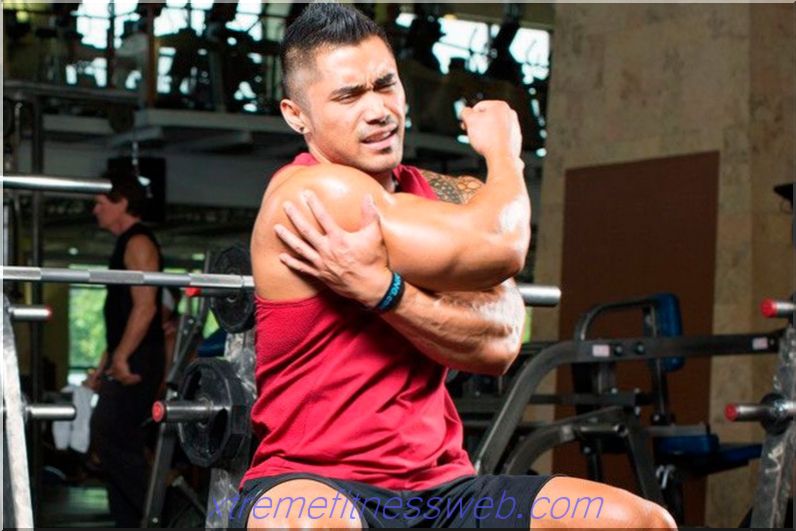
Reverse push-ups from the bench to triceps is a common exercise. Many consider it to be a “newcomer” of the boards, but biomechanically it is a different movement. It includes the medial and lateral heads of the triceps. Exercise is often used as an auxiliary in strength sports, and even more often in fitness, because it is accessible to beginners, and can be used by fairly advanced people too.
Exercise helps to diversify the training, which allows you not to get bored if you are a fitness player, and to achieve a better workout of muscles - if a bodybuilder. It is suitable for home training, you just need to sit on the sofa and take your starting position. Exercise can be done on a park bench too. In general, it is universal, and can be used both in sports and in physical education training.
Exercise is considered simple, but has several technical nuances, ignoring which can lead to the fact that a person simply wastes time and does not train his triceps.
Content
- 1 Benefits of Exercise
- 1.1 Beginners
- 1.2 For pros
- 1.3 Girls
- 2 Classic execution technique
- 2.1 Performing exercise with weighting
- 3 Common mistakes
- 3.1 Pain in the elbows and shoulders
- 3.2 Incorrect hand positioning
- 3.3 "Stand" at the top of the exercise
- 3.4 Injury Training
- 3.5 Moderation in work with weight
- 3.6 Bars - in a separate training cycle
- 3.7 Check the benches in advance
- 4 Bench push-up program
- 4.1 7-week push up program
The benefits of exercise

This exercise is used not only in "female" complexes for weight loss. Trainees for the purpose of gaining muscle mass will “surprise” their muscles with its help, powerlifters will train triceps in a fairly easy mode, and crossfitters will get a fairly convenient ancillary exercise for all press movements.
For beginners
The biggest problem for beginners in bench and standing presses is elbows that are turned at the wrong angle. Many try to reap a lot of weight, placing their forearms at right angles to the body, which is not optimal. This method of bench press is also traumatic, so it should be avoided by everyone.
The second point is the lack of a sufficient level of training to work with the barbell. Starting with back push-ups with the weight of our own body, we can strengthen not only the muscles, but also the ligaments so that we can squeeze the bar without distortions and tremors.
The third point is the lack of a habit of controlling the depth of movement. This triceps exercise is not possible to "redo", such as push-ups on the uneven bars. Excessive depth in motion will not prevent you from training, and your shoulders will be in order.
Exercise also develops mobility in the shoulder joint, which is good for beginners who plan to learn gymnastics.
Crossfit movement helps beginners improve their results in a wide range of exercises, from jerks and jerks to simple push-ups from the floor.
In general, for beginners, push-ups from the bench are a universal option.
For pros

Experienced athletes can perform this exercise not only with simple support on two benches, but also with weight. There is no fundamental difference - some prefer to put pancakes on their hips from the bar, others prefer sandbags. It is important to load the muscles so that the exercise is performed in a forceful manner.
Bodybuilders like to do this exercise “on the pump”, that is, in multi-repetitive mode, at the end of the training, so that the results of working on yourself are immediately visible.
Girls

This exercise is often prescribed for girls, since not all of them can be squeezed out on the uneven bars without compensating for part of the body weight with rubber. But push-ups from the bench are not a “special female” exercise, and cannot be considered as such. Moreover, it does not replace other exercises in women's training.
In aesthetic sports, it is often used because athletes place breast implants, and it is uncomfortable for them to perform other movements. Well, and of course, you need to swing triceps because those who do not shake it do not look their best. The flabby back surface of the hands adds age, and spoils the overall look, even if the figure is slim.
Almost everyone can choose an adequate triceps exercise technique for themselves. For some, the only option is with the legs on the bench and the body parallel to the floor, for someone with the “legs on the floor” stand. Both can be performed with weights. In fact, standing with legs on the floor is not an attribute of beginners or a sign of muscle weakness or something like that. This is just an option for those who are uncomfortable with excessive bending of the shoulder.
Classic technique

Reverse push-ups can be done at home or in the gym. Those who feel discomfort with their knees fully extended can use the knee pads or bend their legs slightly so that the main load does not fall on the joint. This will help to ensure stability of movement, and avoid injuries.
At home, you can do the exercise, resting your hands on the sofa, and putting your feet on a chair. In the exercise room you need to use two benches. We rest on one with our hands, the second serves to put our feet on it
The technique is as follows:
- We set benches at a distance of about the length of our legs;
- We sit on one of them, rest our palms on the bench so that the hands are at the same distance from the conditional line of the spine. It is better not to put your palms more than 5-7 cm on opposite sides of the sides;
- We put the heels on the second, bend our knees a little, and firmly fix our legs;
- We bend our arms in the elbow and shoulder joints at the same time, we lower our pelvis down to the level when the forearms become parallel to the floor;
- With an exhalation, we extend our arms bent at the elbows;
- Repeat the specified number of times
Variation with feet on the floor is suitable for beginners, as well as those who have problems with the position of the legs. With a certain structure of the ligaments of the knee joint, the heel stand on the bench may not be comfortable, and even conscious control of the position does not save.
Staging with feet on the floor is different in that the emphasis here should be on the position of the spine, not the legs. Its axis should be strictly perpendicular to the floor, legs bent at the knees about 30 degrees apart from the bench at a comfortable distance. At the same time, the knees can be bent and stronger if the athlete is tall and cannot otherwise perform the exercise to a sufficient depth.
Doing exercise with weighting

It is logical that with the growth of fitness, the athlete begins to use weights. Obstruct this natural process is not worth it. As soon as it became simple to perform 15 repetitions of push-ups, muscle failure does not occur, and movement can continue for minutes, it is worth refusing to repeat the same thing, and begin to make movement with additional resistance.
As a burden use a sand run or pancakes from the bar. It is believed that making pancakes is more difficult, since they require the additional inclusion of stabilizer muscles, but this is not true in all cases. It’s more convenient for some people to do pancakes.
The sand run is more stable on the hips, you can take it if the legs are voluminous, the quadriceps are rigid and the pancakes "roll". You can use other options, for example, to put a person with a small weight on his feet, but this is already extreme.
The weighted technique is no different from the usual one, you just need to control the weight, which maintains a stable angle in the hip joints, and the position of the spine does not change. When it becomes difficult, a person is inclined to take his pelvis away from the bench, this cannot be done with a burden without losing weight.
Common mistakes

This is considered to be a simple exercise. But for some it does not fit anthropometrically. If a person has a long back and fairly short hips, he will either have to put standard fitness benches on stands, or refuse to perform, as it will be difficult to choose a comfortable position in this exercise.
Usually people take the pelvis away from the bench, or make a movement, initially putting their hands at different distances from the pelvis. Both that, and another does not allow to optimally load triceps in order to train it well. Otherwise, it is difficult to make any serious mistakes. Therefore, this movement is given to beginners because if discomfort or pain occurs, they simply can stop, and for this they will not need to jump from the bars, or return unstable weight to the racks.
Elbow and shoulder pain
Pain in the elbows and shoulders is a fairly common phenomenon in sports. It can occur without any connection with this exercise. The elbows can begin to hurt, for example, due to the significant training volume in the squats, when the weight presses on the ligaments while on the back. Aggravation happens in this simple ancillary exercise.
Technically, in push-ups from the bench there is no excess angle, or anatomically not natural movement at the elbows, it is rather difficult to injure them here. But if the elbows already hurt, weights should be abandoned in favor of first a complete rest, and then training in less stressful triceps isolating movements, for example, with extension of the arms in the elbow joint on the block.
For pain in the shoulders, first you need to check how they are tipped forward. There is such a violation of posture, in which too strong a trapeze seems to pull the shoulders to the chest, and a person simply can not push up without overloading the front delta. The good news is that it is muscle tension that provokes pain, the bad news is that you need to change the technique of performing all the exercises and monitor your posture in life, most likely, the trapezium “works out” here too.
Wrong hand position
To physically put your hands too narrowly will not work, this value is limited by the width of the pelvis of the athlete. But setting the arms too wide can lead to errors in the process of executing the movement itself. If you put your palms wide, the elbows will be directed to the sides, this will lead to an overload of the elbows and shoulders, and the removal of the target load from the triceps.
It is necessary to choose such a palm setting so that the pelvis does not interfere with the movement, and the exercise is comfortable.
"Stand" at the top of the exercise

This is a fairly common technical error when a beginner just stands in the upper phase of the exercise and does not try to perform the movement smoothly and dynamically at the same time. During the stance, the working muscle “unloads” and a significant portion of the body weight falls on the athlete’s wrists. This is not particularly welcome if push-ups are weighed. In any case, this technique does not help in the development of triceps.
Athlete Injury Training
Injuries that have already occurred require special attention when preparing a plan. The athlete with injuries to the joints and ligaments is not recommended training plans for "conditionally healthy" people. If we are talking about injuries of the elbows and shoulders, it is better to perform only extension on the block with a pigtail with light weight, and not push-ups. The static load on the joint may be too high.
Returning to training after a downtime, you need to start push-ups without weight, even if you used additional weights before. Entering the training regimen gradually, the athlete protects himself from new injuries.
Moderation in work with weight

It is necessary to use additional weights, but it makes no sense to replace the bench press with this movement. The exercise is not intended to develop pure strength, so you should not collect all the pancakes in order to provide yourself with a load. When working with weight, you need to be careful. If necessary - load and “unload” pancakes with the help of the insurer.
Bars - in a separate training cycle
Exercises on the bars develop a good triceps and pectoral, but overload the shoulders. If in one plan to combine this movement and the bars, you can get injured in the front delta and joint when the load "accumulates". It is worth avoiding combining both exercises on the same day, or even on the same plane, if the athlete's priority is heavy bench press.
Check the benches in advance
They must be stable and not slip on the floor. It makes sense to fix them additionally on the sides with weights or dumbbells, if we are talking about ordinary fitness benches.
Bench push up program

Such things are necessary for sports quite rarely. Usually, “push-ups from anything” programs are carried out by individuals hoping to gain muscle mass with the help of only exercises with their own body weight.
In fact, this is not the best way to increase fitness. Performing exercises with a body weight of 50-100 repetitions means improving muscle endurance. It may come in handy, perhaps, in crossfit, but not in life, martial arts or, especially, in strength training.
The principle of compiling such a program is quite simple. You need to linearly increase the number of repetitions, training push-ups twice a week:
- On the bench press (chest), the movement is performed with a relatively hypertrophic regimen, in 5 sets of 8-12 repetitions. Between the approaches, rest is 90 seconds, it is worth increasing either the weight of the burden, if the goal is really hypertrophy, or the number of repetitions if a person is training for crossfit or similar disciplines.
- On the day of training the back or back, they perform 2 sets of 20 reps in a pump-style, and also try to increase the number of repetitions;
- If we are talking about a complete beginner, he starts by using only the first option and trains once a week, on the rest of the days without performing any triceps exercises
7 week push up program
| Week 1 | 5 sets of 8 | 1 to maximum |
| Week 2 | 5 sets of 10 | 1 to maximum |
| Week 3 | 5 sets of 12 | 2 to 20 |
| Week 4 | 5 sets of 8 plus weight | 1 at maximum with weight |
| Week 5 | 5 sets of 10 plus weight | 2 at maximum with weights |
| Week 6 | 5 sets of 12 plus weight | 2 at maximum with weights |
| Week 7 | Unloading - 5 to 20 without burden | Control point - without burden, but at maximum |
There are other options for linear programs, the simplest is to increase the number of repetitions from week to week, as soon as you reach the limit - return to the original number of repetitions, but add burdens.
In principle, the reverse push-ups from the bench is a simple exercise that everyone can learn to perform for many repetitions.







